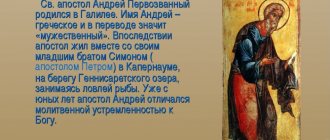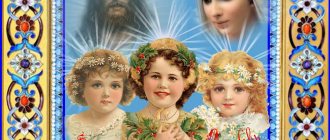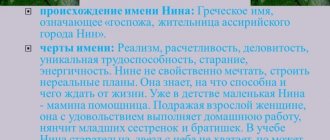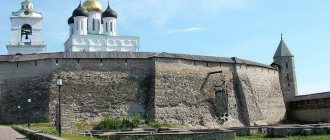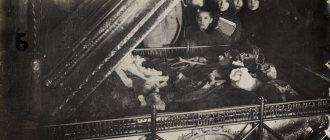Often people have a question about when to celebrate the day of the angel, that is, name day. In theory, this is the holiday of the saint in whose honor the person was named during baptism. But there can be many saints of God with the same name. How can you find out exactly who you are if you were baptized in childhood and no one remembers in whose honor? In such cases, they choose as their patron the saint whose memory in the church calendar is closest to the person’s birthday.
Below we present, accompanied by brief biographies, the main dates when the day of the angel Julia can be celebrated. But first it should be noted that this name does not exist in the Orthodox tradition. According to the church calendar, Angel Julia's Day will be celebrated in memory of Saint Juliana or Julia. It is these names that are the church equivalent of the usual secular form of the name Julia.
Name day dates and Angel Ulyana's day
Ulyana's name day is celebrated 22 times a year. One of these dates is considered Angel Day. To determine it, it is necessary to find in the church calendar the day of remembrance of the saint, which follows the date of birth of the birthday girl.
| Date of: | Saints named Juliana: |
| January 3 | Vyazemskaya, Nikodimiyskaya |
| January 15 | Lazarevskaya |
| March 12 | Olshanskaya |
| March 17 | Ptolemaidan |
| April 2 | Amisian |
| 16th of May | Moscow |
| May 31 | Ankirskaya |
| June 15 | Vyazemskaya |
| June 23 | Lazarevskaya |
| June 25 | Olshanskaya |
| July 6 | Lazarevskaya |
| July 16 | Vyazemskaya |
| July 19 | Olshanskaya |
| July 29 | Carthaginian |
| August 6 | Vyazemskaya |
| August 30 | Ptolemaidan |
| August 31 | Martyr Juliana |
| September 3 | Moscow |
| October 11 | Olshanskaya |
| October 23 | Olshanskaya |
| November 14 | Rossonskaya |
| December 17 | Iliopolskaya |
According to church canons, the name Ulyana must be pronounced in prayers as Juliana.
JULIANIA
Right Juliania Lazarevskaya. Fragment of the icon “Murom Wonderworkers, with the Lives of the Holy Blessed Princes. Peter and king. Fevronia." 1699 (MIHM)
Right Juliania Lazarevskaya. Fragment of the icon “Murom Wonderworkers, with the Lives of the Holy Blessed Princes. Peter and king. Fevronia." 1699 (MIKHM) The image of I., apparently, was painted during the life of Kallistrat (Druzhina) Osorin, when the veneration of his righteous mother began in Murom. The icon is mentioned in the Life of I. in connection with one of the healings at her tomb: “The village of Lazarev... the wife of (cleric) Agathia’s right hand fell away... and blessed Ulyaneya appeared to her in a dream, saying: “Go to church... and venerate the icon of the righteous Ulyaneya.” ... to her image"; she will do this..." (Evgeny (Mertsalov). 1910. P. 7-9). The image was obviously in the c. Cathedral of the arch. Michael, elevated to mid. 10s XVII century above I.’s resting place, next to c. right Lazar in the village. Lazarev near Murom.
In the original text of the Life, probably, Kallistrat Osorin himself made certain additions and changes that made “the very image of the right. Juliania more iconographic or ascetic” (Ibid. pp. 10-11). When describing I.’s dormition, the author deliberately creates a visible verbal “icon”: “...and he will give peace and forgiveness to everyone, reclining, and crossing himself three times, wrapping his chotki around his hand, the last word of his speech is: “Glory to God, for everyone’s sake!” In Your hands, O Lord, I commend my spirit, Amen!” And she gives up her soul in the hand of God, Whom you love, and everyone saw a circle of gold around her head, as it is written on icons around the heads of saints” (The Tale of Ulyaniya of Murom. 1860. P. 67).
In the consolidated iconographic original of the 18th century, which belonged to G.D. Filimonov, an icon is described, a kind of portrait of St. the Osorin family, which could have been created in the 2nd half. XVII century (judging by the note about the “old icon” and the postscript about the living grandson of the righteous woman): “Holy Righteous Juliana of Murom on the Ilevna River; in the likeness of Elizabeth, on the head of the dress is green, the upper robe is cormorant, the underside is blue, the right hand is pressed, there is a ladder in the shuyts. And her husband Georgy was sitting on top, wearing a coat like Gregory the Theologian, a princely fur coat, cinnabar, green underwear, wearing a hat; and her daughter, the schema-monk Theodosius; there is writing on the old icon. And her son Dimitri, he now has a son Avramiy in the Starodub district” (Filimonov. Iconographic original. P. 43; see also: PE. T. 11. P. 21-22). Similar descriptions with some variations are found under January 2. in the originals XVIII century (BAN. Strict. No. 66. L. 69 vol.), 30s. XIX century (IRLI (PD). Peretz. No. 524. L. 107). In an 18th century manuscript. from the collection of S. T. Bolshakov I. is also compared with rights. Elizabeth (Bolshakov. Original icon painting. P. 62); in the original of the 20s. XIX century it is said: “Like Elizabeth, a cinnabar robe, green underneath, a cross in the right hand, a prayer service on the left” (RNB. Weather. No. 1931. L. 86 vol.). An important detail of I.’s iconography is the image of a lestovka in her hand, emphasizing the piety and constant prayer feat of the righteous woman, as described in the Life: “She ceaselessly, holding a rosary in her hands, saying the Jesus Prayer...” (The Tale of Ulyaniya of Murom. 1860. P. 65 ).
Information has been preserved about the icons of I., which could have been quite early and testified to the veneration of the righteous woman in the 2nd half. XVII century These include “the icon of the righteous that was in the iconostasis of the Lazarus Church (Cathedral of Arch. Michael - O.S.) at the northern gate. Juliana with a prayer to her" (Evgeny (Mertsalov). 1910. P. 15-16). The icon of I. is also mentioned, painted “on a tree together with Saints Peter and Fevronia, the Murom wonderworkers” (Ibid. p. 19). Currently time of the icon I. only with the faithful prince. Peter and King. Fevronia is unknown, but on the icons of the Cathedral of Murom Saints her image was traditionally placed next to them.
On the icon of “ancient Greek painting” from c. Cathedral of the arch. Mikhail I. was depicted together with 5 Murom miracle workers. A similar “ancient” icon was once in the Kazan (Nikolo-Mozhaisk) church in Murom (Ibid. pp. 20, 33. Note 2). Another image (25x28.5 cm), coming from c. The Dormition of the Virgin Mary in Murom was recorded (without dating) in the records of the Murom Museum of the 30-40s. XX century (not saved?). On it, I., together with the Murom miracle workers, stood in prayer to the Savior Not Made by Hands on the sides of a “small white temple” on a gold (above) and blue (below) background.
The icon with the marks of the life of I. was in the church of the Muska churchyard until the beginning. 30s XX century and was revered as miraculous (not preserved, described in detail in 1909). The service of prayers for I. did not stop here even during the period of the ban on prayers for I. and rights. George from 1801 to 1867-1868. The memory of the saint in the church in the churchyard was celebrated not on January 2, but on the 10th Sunday after Easter: “Before the religious procession on the same day, before the liturgy, they go to Lake Svyato - the place of the appearance of the miraculous icon, where they wash themselves with water and wash their children ... especially pilgrims prefer to pray before the icon of St. Juliana with her infants” (Ibid. pp. 25-26, 34). According to local folk legend, “this icon appeared long ago on Lake Svyate, 4-5 versts from the churchyard, from where it was brought to the temple.” It was placed in a special icon case behind the right choir, and was “up to 20 vershoks in height, and up to 12 vershoks in width” (88x52.8 cm). In 1932-1933, before the closure of the church in the churchyard, the icon miraculously “gone” to Lazarevo (Epanchin. 2002. pp. 40-41).
In the center of the icon I. was depicted full-length, praying (“with two fingers”) to the Savior. In 6 stamps (“on the right side of the face”, 2 in a row) it was presented: “... in the 1st, her marriage: crowns were laid on the heads of the couple and in the middle of them the priest performing the sacrament, in the 2nd - the home prayer of righteous Juliana before the image the Savior, in the 3rd - her reverent service to her husband; a nobleman is depicted sitting in a chair, his wife stands in front of him, and in the middle of them is a table on which stands a vessel in the form of a chalice; in the 4th - righteous Juliana gives alms to 2-3 beggars; in the 5th, her burial: the clergy are visible surrounding the coffin, and in the 6th, the finding of St. her relics with the upcoming clergy and several persons. The writing style is not Italian or Fryazhsky, but rather ancient Greek” (Evgeny (Mertsalov). 1910. pp. 25-26. Note 1).
The iconographic scheme of the image is largely related to the monuments of the Murom circle of the 17th century. The first composition representing the wedding of I. and rights. George in the temple of rights. Lazar in the village. Lazarev, could go back to the mark depicting this sacrament on the Murom icon of 1618 “Blessed Princes. Peter and king. Fevronia in the Life" (MIKHM, publ.: Icons of Murom. 2004. P. 150-167. Cat. 19). The wedding plot is rare in Russian. icons The motif of “salvation in the world” in the family is heard in the Lives of the Blessed Princes. Peter and king. Fevronia, in the Life of I. it becomes the main theme. It is generally accepted that in the wedding scene it is right. George and I. was depicted as a priest. Potapius (Pimen), after tonsure, was appointed archimandrite of the Spaso-Preobrazhensky Monastery in Murom.
Right Juliania Lazarevskaya. Icon. 1925 Artist. D. S. Stelletsky (C. St. Sergius of Radonezh, Paris)
Right Juliania Lazarevskaya. Icon. 1925 Artist. D. S. Stelletsky (C. St. Sergius of Radonezh, Paris)
The fourth mark, where I. gives alms, is also close to a similar composition on the icon of the noble princes. Peter and king. Fevronia. They are united by the motive of personal participation in the fate of the “orphan and wretched” and the distribution of alms with their own hands, and not through servants. In the 3rd mark I. was shown as a wife in “respectful service to her husband.” This scene, completely “worldly”, probably resembled scenes on popular prints and objects of decorative and applied art of the 17th-18th centuries, where the correct behavior of a wife in the family circle was shown, corresponding to the instructions of “Domostroi” - lit. monument that influenced the work of Kallistrat Osorin (Buseva-Davydova I.L. Life of Juliania Lazarevskaya: Experience of interpretation // Uvarov Readings-5: Proceedings of the scientific conference, dedicated to the 1140th anniversary of the city of Murom, May 14-16 2002. Moore, 2003. pp. 106-110).
About veneration in the beginning. XVIII century in the village Lazarev I. as a saint is evidenced by the shrine built in 1710 and the canopy over it (1713), as well as the silver reliquary cross (MIHM), placed in 1704 in the c. in honor of the Cathedral of Arch. Mikhail in the village Lazarev to the relics of the righteous woman (see: Sukhova O. A. Reliquary crosses in the collection of the Murom Museum // Stavrografichesky collection. M., 2005. Book 3. P. 534-536. Cat. 3).
In the 2nd half. XVIII century Church authorities began to interfere with the veneration of the righteous woman. In 1801, a secret investigative file was compiled about the coffin of I. From the materials of the case it is known that in the temple of the village. Lazarev, a kind of tombstone complex was formed: “... the shrine was placed on the left choir of the temple, and at the “foot of the tomb” there “stood” an icon of the righteous Juliana with her life, painted, and on the tomb itself there were two shrouds with her image” (Evgeniy (Mertsalov) 1910, p. 19). Probably, the hagiographic image at the tomb was close in the composition of the marks to the revealed icon from the Muska churchyard. Two shrouds with images of the saint lying on the tomb could serve as a sewn cover. It is unclear from the description when they could have been created, but most likely ca. 1710. In addition to these works, the church also had icons with the image of I., 3 of which are mentioned above among those considered “ancient”, and one was “painted on canvas,” apparently in the 2nd half. XVIII century At the end of the investigation, all the icons of I. were removed from the temple and placed in the sacristy of the bishop's house (Ibid. pp. 18-19, II). The diocesan authorities attempted to destroy the tombstone complex and bury the coffin in the ground, but by decision of the Synod, the tomb was left, however, without the icons “painted in the name of that Ulyany” (Ibid. pp. 19, 24).
Descriptions of lost Icons (probably from the 17th-18th centuries) indicate that its iconography developed over several centuries. directions and was as diverse as that of other Russians. saints, including Murom. The first (until the 40s of the 17th century), obviously, was her gravestone icon, then similar works were painted as prayer images. Soon they created an image where I. was presented together with her husband and daughter. Presumably at the same time, icons of the righteous woman appeared in the life. Probably in the 2nd half. XVII century The saint began to be depicted on icons along with other Murom wonderworkers. Early works of the “personal” and hagiographic types have not survived, because they were removed from church use in 1801, and some disappeared after 1917.
The icons on which I. was presented at the Cathedral of the Murom Wonderworkers were, apparently, subject to bans less than others. Several have survived. monuments of the 17th - early XIX century (MIHM), where I am depicted among other Murom saints. They depict the image of the righteous woman, as imagined by people who knew about her from their parents, but at the same time inscribed within the framework of the canon.
The earliest in the iconography of I. is the icon “Murom Wonderworkers, with the Lives of the Blessed Princes. Peter and king. Fevronia" 1669 (MIKHM, see: Icons of Murom. 2004. pp. 218-227. Cat. 39) - a bright and original monument to icon painting of the 2nd half. XVII century, testifying to the original local tradition that had developed by this time. The image was commissioned and executed in Murom for the Posad church of the Great Martyr. George in Kozhevniki (“October 7178 in... day[y] the icons of the Resurrection of Christ and the Murom wonderworkers and martyrs of Christ George and Nikita and Boris and Gleb were painted on the page [as]tyakh according to the promise of Sidor Matveev and Lopatin’s son”). In pre-revolutionary sources, I. is designated as an “unknown person” (Inventory of the ancient churches of the city of Murom and the ancient objects found in them, late XIX - early XX centuries: RKP // Scientific archive of the MIHM. No. 29. L. 50 ).
Holy books Peter and king. Fevronia, right. Juliania Lazarevskaya. Fragment of the icon of the Mother of God “The Most Bright Star”. 1690? Icon painter A. Kazantsev (?) (MIHM)
Holy books Peter and king. Fevronia, right. Juliania Lazarevskaya. Fragment of the icon of the Mother of God “The Most Bright Star”. 1690? Icon painter A. Kazantsev (?) (MIHM)
In the middle of the icon are written the most famous local miracle workers: blgv. Princes Konstantin, Mikhail, Theodore, Peter, king. Fevronia and I. (today this is the oldest surviving image of the Cathedral of Murom Saints). The miracle workers stand in prayer to the image of the Mother of God “of the Sign” in a segment of cinnabar “sky”, below there is dark green soil with herbs and flowers. I. is shown on the far right, full-length, half-turned to the center, next to the faithful princes. Peter and King. Fevronia, whose cut she resembles in height and partly in clothing. I.'s secular attire is almost no different from the monastic vestments of St. princesses, only in brighter colors: on the head there are dresses of a greenish tint, outer clothing is red-orange with a crimson lining, and the lower robe is light green; the right hand is raised in a prayer gesture (the hand is folded into a “handful”, like that of the main king Fevronia), in the left there is a rosary made of white beads, called Ulyaniya. The time of writing the image coincides with the formation and dissemination of the “Murom Collections”, which already included the Life of I.
The next work in time of creation with the image of I. is the icon of the Mother of God “The Blessed Star”, with the falling Murom miracle workers (1690?, MIHM, see: Icons of Murom. 2004. P. 284-287. Cat. 53). A rare icon in terms of iconography (see the articles “The Most Bright Star”, the icon of the Mother of God, “The Most Bright Star”) comes from the Cathedral of the Nativity of the Most Holy. Virgin Mary in Murom and is attributed to the authorship of local isographer A.I. Kazantsev. They fall at the feet of the Mother of God in prayer: on the left - blgv. Princes Konstantin, Mikhail, Theodore, on the right - the noble princes. Peter and king. Fevronia, I. (far right). The latter is depicted by the icon painter half-turned to the center, with her knees slightly bent; she has a beautiful face with large eyes, a thin nose and a small mouth. She also has similarities with blgv. Kng. Fevronia - the color of the righteous woman’s clothes is similar to a monastic robe, a reddish cassock and the dark doll of St. princesses, both have the same hand movement. At the same time, the colors of the vestments, gestures and details of I.’s iconography basically correspond to the indications of the iconographic original: her shawl and lower robe are of a greenish-brownish tone, the upper “chabe” is of a reddish (“cormorant”) color, her right hand is pressed to her chest, in her left - rosary, similar in type to a ladder with sewn leather or woven steps.
On Murom icons I., as a rule, is depicted near the noble princes. Peter and king. Fevronia opposite the group of blgv. princes Constantine, Michael and Theodore. One of the samples is a small holy icon “Cathedral of Murom Saints”, con. XVII century from the collection of I. S. Kulikov (MIKhM, see: Icons of Murom. 2004. pp. 278-279. Cat. 51), created at the time when the composition “Cathedral of Murom” was finally formed in the church tradition, literature and iconography saints." In the center of the middle is the Murom Kremlin with the Cathedral of the Nativity of the Holy One. The Virgin Mary, which has become a symbol of the “God-saved city of Murom” (according to researchers, the wooden Kremlin is depicted with some degree of reliability), on the left and on the right there are 3 figures of Murom saints praying to the Savior for the city. I. occupies the usual place on the far right next to the bldg. Kng. Fevronia (clothing in almost the same tones as the blessed princess), in her left hand is a white rosary.
Judging by its size, the icon could belong to the number of pilgrimage and “distributing” images of the same type. This is confirmed by another icon, similar in iconography, style and time of creation, “The Cathedral of Murom Saints” (CMiAR, brought from Khvalynsk, where it came from Cheremshan; see: Icons of Murom. 2004. P. 29. Ill. 19). Its peculiarity is the image of the figure of I. kneeling in prayer in the foreground, separated from other Murom saints by the Kremlin wall. This corresponds to the sacred topography of Murom and its environs, since the relics of St. Murom princes were in city churches, and I. was buried outside the city, in the church of the village. Lazarev.
Presumably I. is one of the figures on the frame with the Murom Icon of the Mother of God and with the upcoming saints (XVIII century, State Historical Museum). The plot and iconography indicate the Murom origin of the icon: in the middle of the 1st quarter. XVIII century presented by blgv. princes Konstantin, Mikhail, Theodore, to the right of them on the frame are the noble princes. Peter and king. Fevronia, on the left - St. Peter, Metropolitan Moscow (?), and women. a figure in secular attire, probably I. In the upper register - the Murom Icon of the Mother of God with the upcoming St. the passion-bearing princes Boris and Gleb, below - “The Miraculous Voyage of St. Vasily, bishop Ryazansky".
Cathedral of Murom Saints. Icon. Con. XVII century (MIHM)
Cathedral of Murom Saints. Icon. Con. XVII century (MIHM)
Blgv. Princes Konstantin, Michael, and Theodore, with the Murom Icon of the Mother of God and selected saints. 1st quarter, 2nd half. XVIII century (GIM)
Blgv. Princes Konstantin, Michael, and Theodore, with the Murom Icon of the Mother of God and selected saints. 1st quarter, 2nd half. XVIII century (GIM)
The cessation of the service of prayers to I., the confiscation of icons and the ban on new images of her influenced the content and composition of the “Cathedral of Murom Saints”. On the icon of this description, with selected saints, con. XVIII - beginning XIX century from the collection of M.K. Levin (MIHM; see: Icons of Murom. 2004. pp. 350-351. Cat. 73) instead of I. next to the faithful prince. Peter and King. Fevronia is depicted as MC. Paraskeva Friday. In the middle of a small 3-leaf folding with the Bogolyubskaya and Muromskaya icons of the Mother of God and the Dormition of the Virgin Mary, beginning. XIX century (MIHM; see: Sukhova O.A. The embroidered cover of the Murom princes // PKNO, 1990. M., 1992. P. 400. Ill.), among the Murom miracle workers on tradition. The figure of I. is placed in this place, but the inscription has been changed (“From Ulyaniya martyr”). On some icons of the 19th century. not 6, but 5 Murom saints are represented (without the image of I.).
After the resumption of veneration of I. bishop. Muromsky Jacob (Krotkov) in 1875, “viewing the church of the village of Lazarev, opened the tomb and instructed to examine the contents in the coffin, and he himself read aloud the handwritten life, cried and recommended the clergy of the village of Lazarev to perform a righteous prayer service. Juliana every Sunday." In 1888, at the expense of the merchant A. M. Nikitin, a new shrine was built, and “in 1889, on October 15, in the church of the village of Lazarev, with a great crowd of people... the transfer of the righteous coffin was solemnly performed. Juliania from the former ancient shrine to the newly built richly decorated one” (Evgeny (Mertsalov). 1910. P. 27. Note 3).
Currently time in c. St. St. Nicholas the Wonderworker (Embankment) in Murom there is an I. shrine with hagiographic scenes, the edge was made in 1888 from cypress wood and decorated with gilded copper chased plates (the image of the Lord of Hosts on the lid has not been preserved; see: Sukhova. 2004. pp. 118-120. Ill. on.). An icon was placed directly on the tomb (not preserved, replaced by a new one) with a straight life-size image of the saint (Dobronravov V.G. Historical and statistical description of churches and parishes of the Vladimir diocese. Vladimir, 1897. Issue 4. pp. 216-217). Scenes from the Life of I. are displayed in 4 stamps on the sides of the shrine in ovals with a floral frame: a voice from the icon of the Mother of God, heard by the priest about I.; I. gives alms; phenomenon of St. Nicholas the Wonderworker I. (depicted with a book in his hands, as in the story about the 1st appearance); repose of I. If the main theme of the hagiographic icon from the Muska churchyard is “salvation in the world,” then here the emphasis is on “salvation in the Church.” This interpretation of the Life is associated with the resumption of veneration of I. (Sazonov, Sazonova. 1995. P. 52). Raku I. can be considered as a kind of hagiographic icon, where the role of the middle was played by the image of a saint lying on the tomb.
In the church with Lazarev, certain traditions have developed in the veneration and iconography of I. In the photograph of the interior of the church before its closure in 1931 (MIKHM; see: Sukhova. 2004. pp. 120-121. Ill. on.) it can be seen that near the shrine there is a large icon of I. in full height, with folded arms hands - obviously, this is an image (presumably the last third of the 19th century), taken directly from the tomb. I. is depicted in very modest peasant clothes, which corresponded to the ideas of the rural population about her. In the last years of her life, I. hardly differed in appearance from her “slaves.” In 1914, in memory of the 300th anniversary of the glorification of I., the clergy and parishioners of the Lazarevsky Church ordered a silver cross with enamel decorations for her relics (MIHM; see: O. A. Sukhova. Silver altar crosses in the collection of the Murom Museum (XVII - early. XX century) // Artistic metal of Russia: Materials of the conference in memory of G. N. Bocharov, April 22-24, 1998. M., 2001. P. 90. Cat. 16; She. 2004. Suppl. 135. Cat. 2. Ill. on).
Right Juliania Lazarevskaya gives alms to the poor. Embossed plate. 1888 (Church of St. Nicholas the Wonderworker, Murom)
Right Juliania Lazarevskaya gives alms to the poor. Embossed plate. 1888 (Church of St. Nicholas the Wonderworker, Murom)
Right Juliania Lazarevskaya. Icon. Last third of the 19th century (Cathedral of the Annunciation Monastery, Murom)
Right Juliania Lazarevskaya. Icon. Last third of the 19th century (Cathedral of the Annunciation Monastery, Murom)
Half-length image of I. (with hands folded on his chest) last. third of the 19th century, owned by the priest. Lazarevskaya c. Mikhail Ivanovich Georgievsky, to the end. 80s XX century was kept by a resident of the village. Lazarev E.N. Kalinina, then was presented to the priest of the Murom Church of the Annunciation of the Virgin Mary, who took the icon to the West. Ukraine. In the Annunciation Cathedral in the iconostasis of the warm church before the beginning. 90s XX century (at present in the altar) there was a small prayer image of I. last. third of the 19th century the same version: on her head there is a bluish shawl, the outer clothing is gray, the lower one is green, both hands are pressed to the chest (Chernyshev V. Ya. Muromsky Spassky Monastery: Pages of History. M., 2006. Ill. on) . On the icon (probably 19th century) from the Trinity Church. in the village Dubrovo (Selivanovsky district, Vladimir region, formerly Muromsky district, near Lake Svyato) I. is written in full length. In con. XIX - early XX century in the houses of residents of Murom and the surrounding area there were icons of the Murom saints with the image of I. (in the 2nd half of the 20th century there were 2 similar icons in the collection of local historian A. A. Epanchin).
One of I.’s descendants, Grodno governor M. M. Osorgin, wrote: “The memory of the righteous has always been honored in the family. Juliana, as the ancestor, although her veneration (until 1893) was limited to the family circle... and we didn’t even have an icon of her... I named my daughter, born in 1892, in honor of the righteous Juliana... Due to the lack of an icon of the righteous in the family. Juliana, I turned to the Trinity Lavra of St. Sergius with a request to purchase an icon, and they sent two of them: one for the brotherhood, the other for our family. The righteous one is depicted on a golden background in full height with a prayerful gaze turned to heaven" (Evgeny (Mertsalov). 1910. P. III, 20, 30-31). The icons painted in TSL in 1893 can be judged from modern ones. list (in 1999 brought to Murom from Paris by I.’s descendants, located in the Church of St. Nicholas the Wonderworker (Embassy), see: Sukhova. 2004. P. 124. Ill. on). The iconography differs from the local icons of I. con. XIX century: the righteous woman is presented in ancient Russian. rich red robe (her class affiliation is emphasized) on a golden background.
In Russian In emigrant circles, the icon of I. with hagiographic stamps, painted by the artist, is known. D. S. Stelletsky in 1925 (C. St. Sergius of Radonezh in Paris, see: Tolstaya. 1927; John (Kologrivov), hierome. Essays on the history of Russian holiness. Brussels, 1961; Life of Juliania Lazarevskaya. 1996. Ill. on the region; Sukhova. 2004. Ill. on inc.). According to T. R. Rudy, this artist “was familiar with the description of the “ancient” icon of St. right Juliania, which was once located in the Muskovo churchyard" (Letter from T.R. Rudi dated July 18, 1988 // Personal arch. O.A. Sukhova). According to the iconographic scheme, Stelletsky’s work really corresponds to the ancient revealed image, and the representative appearance of I. in rich patterned clothes follows the tradition of icons from TSL. Dr. The small image of I. was painted in 1930 by the prince. Elena Lvova for the daughter of M. M. Osorgin in Paris (currently in Santa Fe, USA); According to tradition, the half-length image of I. in a white cloth and reddish clothes on a golden background is executed in Old Russian. style.
In the composition “Cathedral of Russian Saints” I. is represented on icons made by masters of the Vygoleksinsky community (a mantle-shaped image in the top rows, on the far right, in lay or monastic attire). This is how she is depicted in the image of the horse. XVIII - beginning XIX century (MIIRK), on the icon of 1814 there are letters from P. Timofeev from the collection of the Central Academy of Music of St. Petersburg and on the Severodvinsk icon of the middle - 2nd half. XIX century from the village M. Gorka, Vinogradovsky district, Arkhangelsk region. (State Russian Museum; see: Images and symbols of the old faith: Monuments of old culture from the collection of the Russian Museum / State Russian Museum. St. Petersburg, 2008. pp. 72-73, 82-85. Cat. 62, 70; see - Markelov. Saints of Ancient Rus'. T. 1. P. 462-463), on the image of the 1st half. XIX century from the village Chazhenga, Kargopol district, Arkhangelsk region. (Tretyakov Gallery, see: Icônes russes: Les saints: [Exposition] fondation P. Gianadda. Martigny (Suisse); Lausanne, 2000. P. 142-143. Cat. 52). The saint is painted with a scroll in her hand (far left in the bottom row, in a green dress and a white scarf) on one of the Russian minaion icons. saints con. XIX century from the Old Believer Danilovskaya prayer house in Kazan (GMIIRT). In profile, with a staff and a candle in his hands, I. appears in one of the groups of ascetics of the 17th century. in the academic mural style of the work of hierodeacons Paisius and Anatoly (late 60s - 70s of the 19th century; renovations in the 70s of the 20th century, ca. 2010) in the Russian gallery. saints, leading to the cave church. St. Job of Pochaevsky in the Pochaev Dormition Lavra.
Mon. Juliania (Sokolova) wrote I. in the group of Murom miracle workers on the icons “All the saints who shone in the Russian land” 1934 (TSL; cell image of St. Athanasius (Sakharov)), beginning. 50s XX century, late 50s XX century (TSL, SDM; see: Aldoshina N. E. Blessed Work. M., 2001. P. 231-239; this version was reproduced by icon painters in the late 20th - early 21st centuries). In the preparatory drawings mon. Juliana to the Russian holy calendar. saints 1959-1962 (private collection, see: Juliania (Sokolova), nun. Russian Saints = Saints of Rus' / Ed. N. Aldošina. [Juväskylä], 2000. P. 46) I. presented on January 2. upright, in boyar clothes (on the head of a scarf), with arms crossed on the chest, together with St. Seraphim of Sarov. For the publication of the liturgical Menaion, Fr. Vyacheslav Savinykh and N.D. Shelyagina proposed a version of the life-size image of I. half-turn to the left, in prayer before the heavenly segment with the blessing right hand of God (Images of the Mother of God and the saints of the Orthodox Church. M., 2001. P. 117).
In the 90s XX century The iconography of Murom saints, including I., was replenished with new images. Priest N. N. Abramov in 1990 painted a large life-size image of I. in the local tradition of horse painting. XIX century, which was placed on the shrine as a tombstone (the original version was made in the ancient Russian style). For Mont-Rei and the temples of Murom, artist. I.V. Sukhov created a number of icons of local miracle workers (see, for example: PE. T. 11. P. 22), in particular, several. variants of the composition “Cathedral of Murom Saints” with the image of I. So, on the icon of 1996 (Trinity Women's Monastery in Murom) local saints stand before the Murom Icon of the Mother of God against the backdrop of 2 cathedrals, I. - in secular clothing, similar in type to the monastic, far left in the 2nd row, above the bldg. Kng. Fevronia. The image is made according to the canon and in the traditions of ancient Russia. painting, but does not copy a specific example, but is an original work. The single image of I. was painted by Sukhov at the request of the parishioners of the Murom Annunciation Cathedral. In 1997, on the day of the consecration of St. source in the name of I. in the village. Dubrove, artist. V. V. Samarova (a novice in the Murom Trinity Monastery) wrote a copy on cardboard from the Stelletsky icon (kept in the collection of O. D. Malova in Murom, see: Malova O. D. The image of the merciful Juliana in my destiny // Gracious : Prav. Juliania Muromskaya (Lazarevskaya). 2004. P. 228. Ill. on the region).
Right Juliania Lazarevskaya. Painting of the Cathedral of the Annunciation Monastery in Murom. 2000–2001 Master A. G. Filippov
Right Juliania Lazarevskaya. Painting of the Cathedral of the Annunciation Monastery in Murom. 2000–2001 Master A. G. Filippov
In 2000-2001 in the chapel in the name of St. John the Theologian of the Annunciation Cathedral of the Annunciation husband. mon-rya Vladimir artist. A. G. Filippov in the style of academic painting. XIX - early XX century the altar barrier was painted. It represents the Murom miracle workers, I., looking like a peasant woman with a ladder in her hands, is placed separately, outside the altar wall, on the wall on the right. The appearance of the righteous woman in a white dress and a dark “cube” sundress, walking with a bouquet of wild flowers through a meadow against the backdrop of the river and the towers of the Murom Kremlin, goes back to the images on the canvases of M. V. Nesterov (Sukhova. 2004. pp. 128-130. Ill. on on). A half-length image of I. in a medallion is included in the painting of the cathedral in honor of the Kazan Icon of the Mother of God in Optina Pust. (c. 2002, artist S. V. Vasyutina).
On the 400th anniversary of I.'s repose, in 2004, the temple in honor of the Cathedral of Arch. Mikhail in the village Lazarev. Zap. the facade of the church was decorated with a bas-relief by the sculptor I. A. Chernoglazov from Vladimir: I. together with rights. George and etc. Feodosia (youth). At the same time, 2 icons of I. with her husband and daughter were painted (artist Sukhov, Church of the Cathedral of Arch. Michael in the village of Lazarev): a small image with life-size upright figures and an icon for a tomb built over the place where the relics of the rights rest in secret . George. There is also a work by the Vladimir icon painter I. Dronov: I. in prayer before the images of the Savior, St. Nicholas the Wonderworker and in front of the Murom Icon of the Mother of God against the backdrop of Murom (the walls and towers of the Kremlin). Dr. an image of the same version of Dronov’s letter is located in the Sretensky Monastery of Gorokhovets. Vladimir icon painter I. Skurikhin is the author of the temple image of I. (in secular clothes, with a rosary in his hand) for the house ts. Muromsky Institute (branch of Vladimir State University), consecrated in the name of I. in 2004.
In the same year, the chapel in the name of rights was consecrated. wives Anna, Tabitha and I. in the Murom Trinity Monastery, in the iconostasis there are embroidered icons made by the sisters of the monastery. The temple image is right. wives in 2006 were performed by the nuns David (Ovchinnikova) and Augusta (Ostrovnaya): I. is depicted upright, full-length on the far right, with her right hand pressed to her chest, wearing a rosary on her left. I.'s rich robe is skillfully embroidered with spun gold of various shades (from white to bright yellow), the saint's face is filled with traditional flesh-colored silk. satin stitch. In 2008, the walls of the chapel were painted with scenes from the lives of St. wives (artist A. Toporishchev from Krasnoarmeysk, Moscow region). To the north The composition “Right. Juliana distributes alms" (bread), to the south. The righteous Anna, Tabitha and I are written on the wall.
Modern Icons are also created abroad, for example. in the USA, where, on the initiative of the descendants of the ascetic, a c. in the name of I. in Santa Fe (Ibid. P. 130. Ill. on). Icons from this temple are half-length images of I. in rich ancient Russian. outfit (blue dress and a patterned red fur coat, on the head - a white scarf or a hat with fur trim on top of it).
Lit.: The Tale of Ulyania of Murom // Monuments of ancient Rus. literature, ed. gr.G. Kushelev-Bezborodko / Ed.: N. Kostomarov. St. Petersburg, 1860. Issue. 1. pp. 63-67; Evgeniy (Mertsalov), bishop. About the church. glorification and veneration of St. right Juliania Lazarevskaya. Murom, 1910; Tolstaya A.V. Prav. Juliania Lazarevskaya. P., 1927; Sazonov S.V., Sazonova E.I. Iconography of Ulyaniya Lazarevskaya // Rus. ist. figures in the icon: Tez. report scientific Conf., Dec. 1989 / TsMiAR. M., 1995. S. 51-53; Life of Juliania Lazarevskaya: The Tale of Ulyaniya Osoryina / Research. and preparation text: T. R. Rudy. St. Petersburg, 1996; Markelov. Saints Dr. Rus'. T. 1. P. 462-463; T. 2. P. 139-140; Epanchin A. A. “The Lord made me a collector”: From local historian. archive of A. A. Epanchin. Murom, 2002; Icons of Murom. M., 2004; Sukhova O. A. The image of Juliania Lazarevskaya in the art of Ancient Rus' and the church. works of the XIX - early XXI centuries // Gracious: Right. Juliania of Murom (Lazarevskaya): To the 400th anniversary of her repose. Murom, 2004. pp. 92-135.
O. A. Sukhova
A little history about the meaning of the name
The baptismal name Juliana presumably goes back to the Roman Julianus. Translated from Latin it means “from the Julius family.” Unmarried Roman women did not have their own names. A woman who was so called could be the daughter or wife of one of the representatives of a noble family.
The name came to Rus' along with Christianity. This is how the Grand Duke of Tver Mikhail Alexandrovich, who lived in the 18th century, baptized his daughter. After this, all classes began to give names to girls: from peasants to nobles. Now Ulyana is one of the rarest Orthodox names.
Finding the relics of the blessed princess
The Cathedral Church of the Transfiguration of the Lord, on the territory of which Juliana’s body was buried, began to collapse over the years. Only after four centuries had passed was it decided to dismantle it and begin construction of a new building.
In 1815, during construction work, part of the sacred tomb became visible. Everyone who touched her received healing from illnesses. This was taken as a sign that the saint approved of the discovery of her relics. People began to often come to the princess’s coffin. In the depression below there was a spring, the water from which cured various diseases.
In June 1819, a chapel was built in the new cathedral in honor of the saint. Here was a precious shrine with princely relics. In 1918, by decision of the Soviet authorities, the temple was closed. Until 1930, the location of the remains of the martyr was the Church of the Archangel Michael. Their subsequent fate remains unknown.
How does the icon of Juliania Lazarevskaya (Murom) help?
Through His saintly icons, the Lord sends us what we ask for, useful for our souls. The saints, just like us, who have walked the earthly path, know our needs. They experienced the same experiences, overcame similar earthly difficulties. When we ask a saint for intercession, we ask that he convey our prayer to God and that the saint’s prayers will be heard faster than our sincere appeal to them. The icon of Juliana Lazarevskaya helps to establish a prayer connection with the patron saint. Having before us the visual image of Saint Juliana, our prayer is not dissipated into empty ideas and dreams. And according to the faith of the one who asks, the Lord, through His saints, gives us what we ask. Anastasia of Rome is revered in the Christian world as a saint and martyr.
Before the icon of Saint Juliana of Lazarevskaya they pray:
— About strengthening faith — About help in organizing earthly affairs — About healing of bodily and spiritual infirmities.
Buy an icon of Juliana Lazarevskaya (Murom)
In the Radonezh icon painting workshop you can buy or order a handwritten icon of the holy martyr Juliana of Lazarevskaya (Murom). Call us and we will help you choose a plot, a compositional solution for the icon, its optimal size and design, or we will write an icon according to your sample.
Free delivery throughout Russia. If desired, the icon can be consecrated in the Holy Trinity Sergius Lavra.
The image of Juliana Lazarevskaya (Murom) made by the icon painters of the Radonezh workshop, like any handmade icon, carries within itself the living warmth of human hands and a loving heart. Each icon painted with love is unique and inimitable.
Peace and goodness to you, dear brothers and sisters, and may the holy saint of God, Juliana, accompany you throughout your entire life’s journey.
Similar icons:
Maria Khidanskaya 13000 ₽
Zechariah the prophet 20000 ₽
Veronica 20000 ₽
Vera Rimskaya 20000 ₽
Icon of Juliania Lazarevskaya (Murom), meaning
The meaning of the icon of Juliana Lazarevskaya lies in the indestructible strength of spirit represented in the image of the saint. She personifies the power of faith, martyrdom, and a firm determination to defend Christian ideals, even at the cost of her own life. The image of Juliania Lazarevskaya, the story of her life’s path, inspire us, encourage us to fervent prayer and pious deeds. Truly wonderful is God in His saints! Dear believers, brothers and sisters! Do not doubt the help of Saint Juliana! Open your heart to her in sincere prayer and she will hear us, heal spiritual and physical infirmities, and help in the successful arrangement of earthly affairs.
Do not forget that in order for a miracle to happen, we ourselves must take care: regularly, with attention, read the prayer, do deeds of faith and love. And don’t forget to give thanks: to thank all the people sent to us by the grace of God to solve our life’s troubles, who shared our joy and sorrow. To thank the Saint, whose prayerful support our heart yearned for, because how many people pray to him for help, but he heard and helped us too. And most importantly, thank the Lord for His boundless love for mankind. He gave the world His saints and every second helps us, people who hope for His great mercies.
Everything in the world happens according to the wise providence of God. Difficulties and sorrows, success and joys. Through earthly trials the Lord strengthens us. By helping each other, praying to the heavenly saints, we are more firmly united in the One Church of Christ. And we believe that the holy martyr Juliana of Lazarevskaya will hear all our prayers and show us the boundless mercy of our Lord Jesus Christ. Thank God for everything!
Burial and posthumous miracles
Having learned about the misfortune, residents of the city of Torzhok began to look for the body of the murdered princess. People wanted to bury her according to Christian rules, with all due honors, but the search was in vain. After some time, the Lord came to the rescue, and the body was miraculously revealed for burial.
Chronicles tell that in the spring of 1407 a man was walking along the bank of the Tvertsa River. With surprise, he saw a woman's body swimming against the current. The man came closer, after which he heard a voice coming from the remains. He was told not to be afraid, but to quickly go to the city of Torzhok and report the find to the local church. The voice also said that the body should be buried on the right side of the cathedral, at the noon doors. The man did exactly as he was told. After this, Juliana was taken out of the river and buried according to her wishes. A shrine and an icon of the martyr were placed above the burial site.
The veneration of the princess began immediately after her burial. A large number of people came to Juliana’s tomb, many of whom received healing from long-standing illnesses and other benefits. Together with her, Prince Simeon was considered a saint, whose relics disappeared without a trace and were not buried.
In 1629, an event occurred that became a warning to anyone who might violate the rules for handling the shrine. A certain John served at the Novotorzhsky Cathedral, who really wanted to see the relics of St. Juliana. Since this was prohibited, he decided to carry out his intentions in secret. After Great Lent, John came to the burial place of the martyr and began to dig up the ground. Suddenly, a flame emerged from the depths and scorched him. Very frightened, the man began to call for help, but his cries were not heard. Burnt and weakened, John was lying on the church platform when Juliana turned to him: “You acted unreasonably, you don’t need to see my body until it is the will of the Lord.” In the evening, John was discovered by a sexton.
The whole city became aware of what had happened. The man who violated the ban remained relaxed. His wife prayed to God every day and came to the saint’s grave, asking her to heal her husband. Only two months later he received forgiveness and began serving in the temple again. The people, seeing such a miracle, began to glorify the holy martyr with even greater joy.


